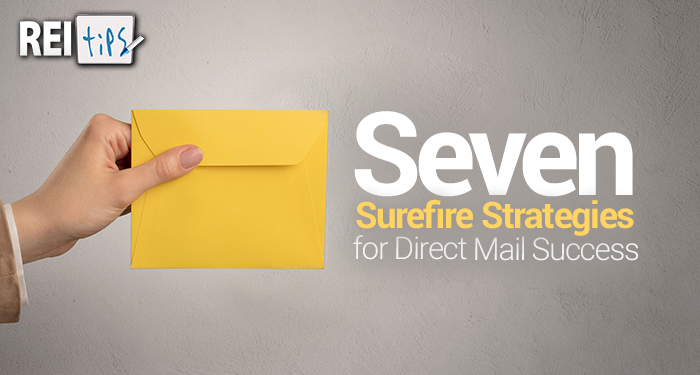Direct mail campaigns can cost you thousands… so whether you’re launching your first mailing or trying to improve your response rates, you want to know you’re sending out a mailing that’s going to get opened, not tossed.
You want the secret sauce that guarantees direct mail success. And today, I’m sharing 7 strategies flavored with that secret sauce.
But before we dive right in, here’s a quick word to help define direct mail success.
Planning for Success
REI direct mailings typically have a 1% response rate.
In other words, if you send out 100 letters, you can expect to get 1 call. (Don’t get discouraged; just set the right expectations.)
Of course you’re targeting for a higher response rate, but even if you get as high as a 5% response, you would still need to send out 2,000 letters to get 100 calls.
Do the math and send out enough letters to make your mailing worth your time.
Your planning isn’t just about the number of addresses on your list, though. And it isn’t over when you’re done writing your letter either. You also need a plan for taking calls—including a script and a list of answers to questions you’re likely to get.
The last thing you want is to invest in a mailing and then lose a deal because you were unprepared on the phone.
Make sure you’re prepared to take the number of calls you’re likely to get from your mailing. You also don’t want to miss out on a potential deal because you’re scrambling to keep up with calls.
Okay… on to our 7 strategies.
1. Follow the Rule of 7
Potential buyers aren’t likely to call you the first time they hear about you and your business. They want to work with someone reliable, someone they trust. You can build that trust by building brand awareness and following the rule of 7.
The rule of 7 says that a client needs to hear about your business 7 times before working with you… of course, 7 isn’t a magic number, and you will get some calls from a first mailing.
But 80% of your deals will come from your 5th, 6th and 7th interactions with a seller.
These interactions don’t all need to be mailings. Sellers can hear about your business through a social media ad, billboard, bandit sign… and several different types of mailings.
The rule of 7 means that you need to commit to (and budget for) multiple mailings to the same list. And you should think about other marketing methods that list is likely to see—including driving for dollars and knocking on doors.
As a rule of thumb, plan for 6 mailings in 6 months (one per month) to your list… and the mailings should tie together. Your message should be the same, but the pieces can build on one another.
For example, you can begin the second letter: “You got a letter from me a few weeks ago. What’s keeping you from calling me about this offer?”
Then remind the seller about the benefits of selling. In the 3rd letter, you can offer to pay for referrals.
“Early to bed, early to rise, advertise, advertise, advertise.”
~Ray Kroc
2. Set a Budget that Follows the Rules
When you’re planning your direct mailing, you need to decide:
 How many people to mail to
How many people to mail to How many mailings to do and when you send them
How many mailings to do and when you send them What type of mailing to send (letter, postcard, etc.)
What type of mailing to send (letter, postcard, etc.)
If you’re on a small budget, there’s nothing wrong with starting small, but don’t just send one or two letters and call it quits. If you do, you’ll miss out on that 80% of your possible deals.
And don’t forget to look at bulk discounts and costs for a few different quantities.
3. Contact the Right People
Even more important than what your mailing says is: who it’s being said to. Even if you come up with an incredibly compelling message, it’s not going to mean anything if it’s not sent to the right people.
The best way to make sure your mailing succeeds is to pay for a list from a list serve or pull county data, but you need to make sure you’re using the right filters to get the right target group.
Use filters like these:
 Location (zip code, city or county)
Location (zip code, city or county) Property value range
Property value range Percent equity (use 50% as a minimum)
Percent equity (use 50% as a minimum) Property type (single-family, multi-family)
Property type (single-family, multi-family) Owner type (in-state absentee, out-of-state absentee, probates, foreclosures)
Owner type (in-state absentee, out-of-state absentee, probates, foreclosures) Length of residence (7–12 years is a good start)
Length of residence (7–12 years is a good start) Age of owner (65+)
Age of owner (65+)
4. Connect with Your Audience
Once you’ve got your list, write a letter the potential seller is sure to respond to. Think about the problems your audience is specifically facing and provide a solution.
Start with your headline or opening. What will make your audience keep reading?
Write 10 headlines or openings and choose the one that’s most likely to keep the people on your list from tossing your letter. Think about the result your potential sellers are really looking for and write an opening focused on that.
In the rest of your mailing, be clear and to the point. What’s in it for the buyer?
Use short, straightforward sentences or bullet points. And keep the mailing simple.
Include a clear call to action. What should the reader do next? Call you? Fill out a form on your website?
Once you’re happy with the message in your mailing, stick with that theme in the rest of your pieces. Again, you’re trying to build brand recognition, so consistency is going to help your potential seller recognize who you are and understand how you can help them specifically.
Make sure your letter is only 1 page and is very straightforward… cut the fluff.
Your goal is to get the seller to call you, and you don’t need to give them every detail of your business in the letter. Less is more here. Give them just enough info to get their attention… and then you’ll discuss the details over the phone.
If you want more content, consider adding a second page with an FAQ focusing on questions that might keep potential sellers from calling:
 How much will this cost me?
How much will this cost me? Do I have to do any repairs before you will buy?
Do I have to do any repairs before you will buy? How long before I get paid?
How long before I get paid? What if I change my mind?
What if I change my mind? Are you a real estate agent?
Are you a real estate agent? What if I live out of state?
What if I live out of state? Do I need a real estate agent?
Do I need a real estate agent?
5. Use the Right Media
Do you want to use postcards or letters? Yellow letters or white? What should the envelopes look like?
Following the rule of 7, you could send a few types of mailings. And sending postcards is cheaper than sending letters, but letters tend to get better results.
Talk to other investors in your area to learn more about what works well with your market. If you’re unsure, stick with letters to start.
Remember, you’re trying to get the potential seller’s attention, and you don’t want them to think your mailing is junk mail, so when you’re making these decisions keep your sellers in mind.
6. Send at the Right Time
You should be sending your mailings about once a month. Know when the real estate market in your area is busiest. Most homes are sold between March and September, so your mailings should include those months.
Everyone is distracted around the holidays, so be mindful of holidays as well, since you’re not as likely to get responses.
7. Experiment… Meaningfully
Keep track of your results for every mailing and make changes as you go. But remember to change 1 thing at a time so that you know which changes make a difference.
Try out a few different types of mailings, different openings and even different features such as stamps on the envelope. Don’t overthink things too much, but always keep improving.
Spending money on direct mail doesn’t equal success. Tracking responses to direct mail and tweaking the mailings = success.
“Marketing without data is like driving with your eyes closed.”
~Dan Zarrella
Stick with It
The most important part of marketing is persistence. Failure is part of the process, and being told “no” is a part of the process.
Be prepared to tweak, improve and keep asking.
And remember that most of your deals are going to come from the last few mailings, so don’t give up after one or two mailings…
Stick to the rule of 7, and if you feel like you’re just throwing money away, remember that you’re building brand awareness and when you hit your fifth mailing to the same contacts, the responses will pick up.
“Consistent action creates consistent results.”
~Christine Kane
Your Take
What works well for you in direct mail campaigns? Which of these 7 strategies are you going to put into place right away? Let me know in the comments below.




